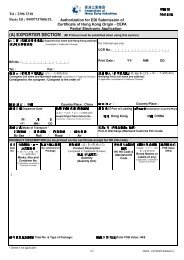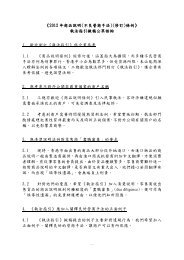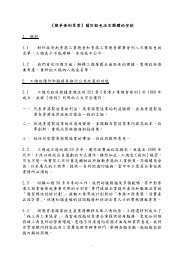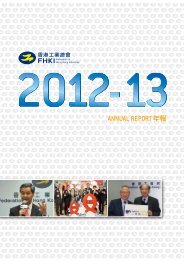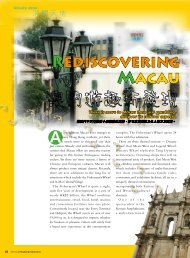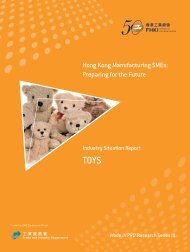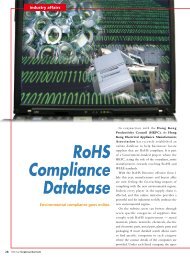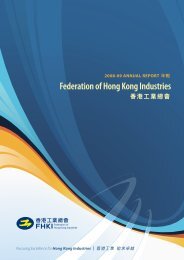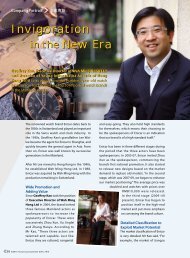Hong Kong Manufacturing SMEs: Preparing for the Future
Hong Kong Manufacturing SMEs: Preparing for the Future
Hong Kong Manufacturing SMEs: Preparing for the Future
- No tags were found...
You also want an ePaper? Increase the reach of your titles
YUMPU automatically turns print PDFs into web optimized ePapers that Google loves.
66Hugo Boss, and Banana Republic. <strong>Hong</strong> <strong>Kong</strong>companies have benefited from <strong>Hong</strong> <strong>Kong</strong>’sopenness, managerial skills, financial sector,international linkages, transportation system, andcommunications infrastructure, while offsettingdisadvantages in labour and o<strong>the</strong>r costs by shiftingproduction into <strong>the</strong> Chinese Mainland.The end of <strong>the</strong> global garment quota system inJanuary 2005 led to a tremendous spike in <strong>Hong</strong><strong>Kong</strong>’s garment re-exports from China in <strong>the</strong>first six months of 2005. Since <strong>the</strong>n, <strong>the</strong> globalgarment trade has steadied, with China’s sharesignificantly higher than be<strong>for</strong>e. <strong>Hong</strong> <strong>Kong</strong> ando<strong>the</strong>r international garment exporters have investedheavily in capacity in <strong>the</strong> Chinese Mainland.Some developing countries such as Bangladesh,India, Vietnam, Cambodia, and Thailand aregrowing <strong>the</strong>ir low-end garment industry. Thesecountries have lower operating costs than China.Some garment companies in <strong>the</strong> PRD haveconsidered moving <strong>the</strong>ir manufacturing factoriesto one or more of <strong>the</strong>se countries, though fewhave done so to date. While industry participantsexpect that South Asia in particular will becomea larger player in <strong>the</strong> low end segments of <strong>the</strong>industry, and that even Africa may become amore significant producer, China will remain <strong>the</strong>dominant production location in <strong>the</strong> garmentindustry <strong>for</strong> <strong>the</strong> <strong>for</strong>eseeable future. Thus it is key <strong>for</strong><strong>Hong</strong> <strong>Kong</strong> firms to be able to continue to leverageChinese production locations, and to competeagainst competitors from <strong>the</strong> Mainland if <strong>the</strong>y areto succeed. While companies that are not ableto distinguish <strong>the</strong>mselves in terms of technology,design, flexibility, reliability, and quality will face atough time, <strong>the</strong>re are enough <strong>Hong</strong> <strong>Kong</strong> firms thatdo distinguish <strong>the</strong>mselves on one or more of <strong>the</strong>sedimensions to indicate that <strong>Hong</strong> <strong>Kong</strong> will retain astrong position in <strong>the</strong> industry.Basic Facts about <strong>the</strong> IndustryGIO and employment in <strong>the</strong> garment sector in <strong>Hong</strong><strong>Kong</strong> decreased from HK$23 billion and 24,000people in 2004 to HK$8 billion and 13,000 peoplein 2008. 128 Average wages <strong>for</strong> <strong>the</strong> garment sectorin <strong>Hong</strong> <strong>Kong</strong> are six times those <strong>for</strong> wages in <strong>the</strong>sector <strong>for</strong> China as a whole. This is likely explainedby general wage disparities between <strong>Hong</strong> <strong>Kong</strong>and China, <strong>the</strong> employment of more senior staffin <strong>Hong</strong> <strong>Kong</strong>, and <strong>the</strong> fact that higher value endproducts are produced in <strong>the</strong> sector in <strong>Hong</strong> <strong>Kong</strong>with corresponding higher quality and more costlylabour inputs. Wages were approximately 23 percent of total costs <strong>for</strong> <strong>the</strong> sector.Exhibit 40. Average Monthly Wages <strong>for</strong> <strong>the</strong>Sector in RMBRegionAverage Monthly Wages<strong>Hong</strong> <strong>Kong</strong> 9,034YRD 1,605PRD 1,710China 1,559Source: Foshan, Dongguan, Shenzhen, Huizhou, Taizhou (JS), Nantong, Shaoxing,and Jiaxing City Statistical Yearbooks, 2009, China Statistical Yearbook, 2009.The total exports from <strong>Hong</strong> <strong>Kong</strong> <strong>for</strong> <strong>the</strong> textileand clothing sector in 2009 were HK$254.5 billionor 10.4 per cent of total exports. Total domesticgarment exports <strong>for</strong> <strong>Hong</strong> <strong>Kong</strong> were HK$4.4billion, a decrease of 80 per cent from <strong>the</strong> previousyear. Re-exports from <strong>Hong</strong> <strong>Kong</strong> <strong>for</strong> <strong>the</strong> textile andclothing sector were HK$247.8 billion or 10.3 percent of total re-exports. Mainland based processingtrade re-exports through <strong>Hong</strong> <strong>Kong</strong> accounted<strong>for</strong> HK$118.4 billion of this total, while Mainlandbased non-processing trade accounted <strong>for</strong> a fur<strong>the</strong>rHK$45.6 billion. Total re-exports originating from<strong>the</strong> Chinese Mainland were HK$164 billion or 6.8per cent of <strong>Hong</strong> <strong>Kong</strong>’s total re-exports, and 66 percent of garment re-exports. 129128 <strong>Hong</strong> <strong>Kong</strong> Census and Statistics Department.129 <strong>Hong</strong> <strong>Kong</strong> Census and Statistics Department.



